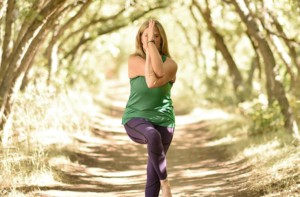 It’s St. Patrick’s Day. As I contemplated how to tie yoga practice to the holiday, I came up a bit short. There’s no Shamrock Pose or Leprechaun Pose. It’s true that we’re “lucky” to enjoy a yoga practice, but that’s a bit general. I settled on today’s color: green.
It’s St. Patrick’s Day. As I contemplated how to tie yoga practice to the holiday, I came up a bit short. There’s no Shamrock Pose or Leprechaun Pose. It’s true that we’re “lucky” to enjoy a yoga practice, but that’s a bit general. I settled on today’s color: green.
There’s the “wearin’ o’ the green.” Wearing something green is easy, but certainly not specific to yoga practice. How about using a green yoga mat? That’s stretching things a bit, so to speak. I’m instead going to discuss a different meaning of “green.”
Green is another word for “sustainable.” In yoga practice, that can include several different interpretations. We can use sustainable yoga mats and props, such as rubber mats or cork yoga blocks. It can also include the attitude we bring to practice.
How green is your yoga practice? Asana practice has the unique ability, among physical activities, of helping us replenish the prana (life energy) we spend during our daily activities. We spend prana when we talk, move about, and use our brains to think and/or solve problems as we move through our day. We take in prana through food, water, breath and what we “feed” our minds. Asana practice, with its unique marriage of breath and movement, can help us restore our energy reserves.
In every asana there are parts of the body that need to engage more fully and parts that can soften. When we tense or harden parts of the body that aren’t directly involved in the foundation of our pose, we are using energy where it isn’t needed, kind of like leaving the lights on in a room you’re not occupying.
Creating a Green Yoga Practice
How can you green your yoga practice? Here are some ideas:
- Set a strong foundation. Whatever is on the ground in your practice is your foundation. In order for your practice to be sustainable, your foundation must be strong and grounded. This allows the areas above the ground to work less. For example, in standing and seated poses, the legs are active and the upper body can soften and open.
- Unwind unnecessary tension. Our shoulders, neck, throat, jaw, forehead and eyes are common areas where we express tension and stress. Check these areas and let go of unnecessary effort. This is one of the freeing powers of our practice. When identify unhealthy patterns in our practice, we have a choice to change our habits. Over time, we develop new habits.
- Free your breath. In every pose, check your breathing. Is it deep and full; does your belly expand and contract as you inhale and exhale? Is it fast, shallow, labored or based in the chest? If you find your breath labored or restricted, do less. Doing the “full” expression of a pose is not nearly as important as maintaining your ability to breathe deeply.
- Feel the aftereffects. If you feel tired or agitated after your asana practice, you might want to re-examine how you’re practicing. Asana practice is supposed to replenish us, not fatigue us.
- Slow down. Not only does a slower practice tend to build rather than deplete energy, but it gives you a chance to investigate how you’re practicing—whether you’re spending energy in parts of your body that don’t need to be working so hard.
- Cultivate contentment. Santosha, the cultivation of contentment, is one of the niyamas on the Eight Limbs of Yoga. When we are content with our lives in this moment, we don’t need to go outside ourselves to find happiness. We can practice santosha on the mat too. Relax into the pose you’re practicing at this moment. There’s no pose out there somewhere in the future—or somewhere in the past—that’s better than the one you’re in now. Be fully aware and alive in this pose, right now.
- Give yourself a generous Savasana. Judith Hanson Lasater recommends at least 15 minutes for Savasana if you want to relax your body completely and allow your mind to settle.
Reflect on your good fortune—somehow you found yoga practice, out of all the possible practices there are to enjoy in this world. Then practice with sustainability in mind. Our yoga practice can be a lifelong companion, as long as we approach it with curiosity and patience. Stay open to how your practice changes from day to day, year to year. And give your practice the care it takes to sustain it for the rest of your life.
